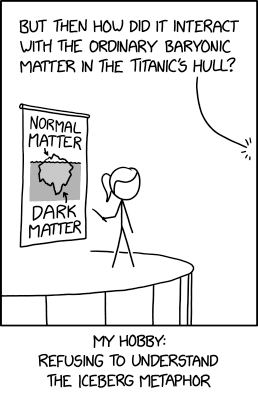Iceberg

90% of the iceberg is hidden beneath the water, but that 90% only uses 10% of its brain, so it's really only 9%.

90% of the iceberg is hidden beneath the water, but that 90% only uses 10% of its brain, so it's really only 9%.
This is another comic in the My Hobby series. The previous comic in this series was 2733: Size Comparisons, released just over 4 months prior. The iceberg metaphor is a famous metaphor sometimes misattributed to Freud. Just as a real iceberg floats with the vast majority of its body below the water's surface (often simplified as 90%, which does quite closely reflect the general range of buoyancy for ice in cold sea-water), the iceberg as metaphor represents a system where the large majority is unseen, invisible, or hidden in some way.
In this case, Ponytail is using it to illustrate the fact that about 95% of the mass in the universe does not appear to be in the form of ordinary ("baryonic") matter, but rather dark matter and dark energy. Dark matter is known to not interact at all with ordinary baryonic matter except by gravity, and has been detected only by its gravitational effects. Excluding dark energy, dark matter accounts for about 85% of the total mass of the universe. So baryonic matter is like the "tip of the iceberg," visible to us above the surface, while dark matter is like the invisible majority of the iceberg below the surface.
The questioner in the audience purposely misunderstands the metaphor by taking it literally, thinking that Ponytail is saying that the part of an iceberg below the surface is literally made of dark matter. He points out that the Titanic sank after its hull was damaged by hitting the underwater part of an iceberg, which wouldn't be possible if it were made of dark matter. Cueball has previously been confused about dark matter in 2186: Dark Matter.
The title text references the myth that we use only 10% of our brain, and we could become more intelligent or powerful by "unlocking" the remaining 90%. If icebergs had brains, and the 90% in the "dark matter" part underwater used only 10% of its brain, while the tip also used 10% of its brain, then most of the cognition would occur in the underwater part. Hence the "9%" figure would refer to the cognition occurring underwater, with 1% of its cognition occurring above water. In reality, human beings use pretty much all of their brain. They just don't use it all at the same time; at any given instant, between 2% and 16% of neurons are firing, depending on how active the brain is in that moment. The effect of using one's whole brain would depend on precisely what is meant by that -- for example, all excitatory neurons firing with no inhibition for a prolonged period would be a seizure (most likely fatal), but there's no reason to exclude inhibitory neurons and adenosine when "using all of one's brain at once".